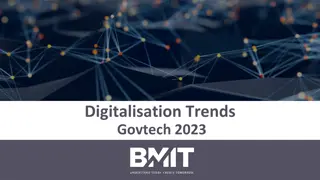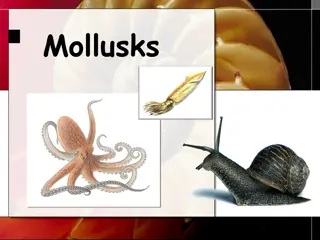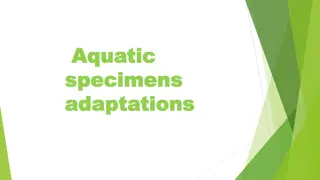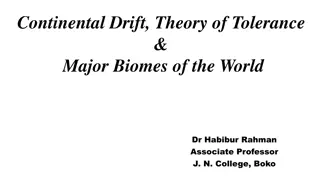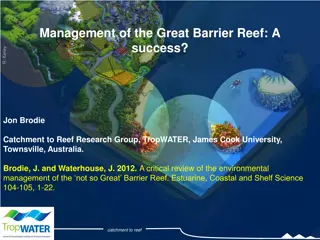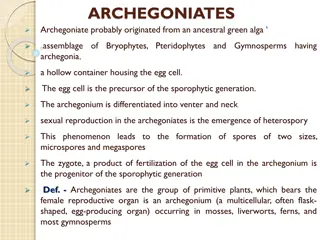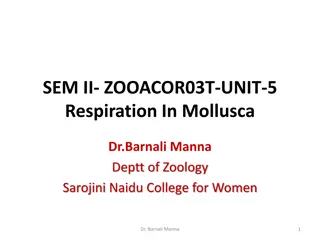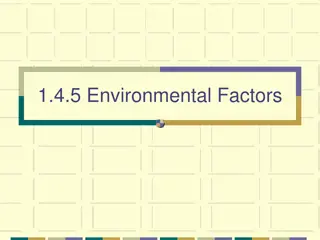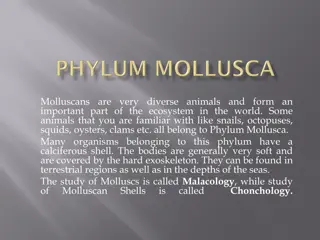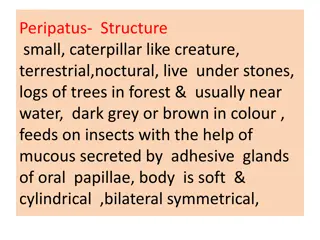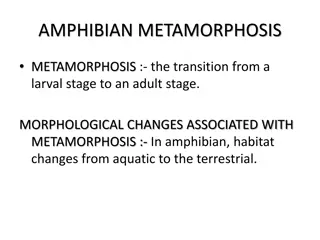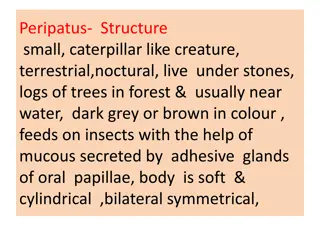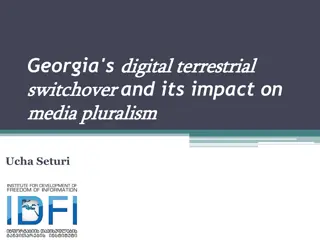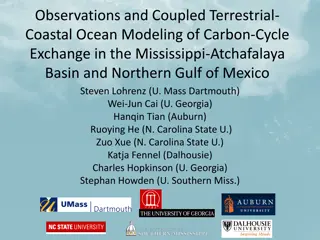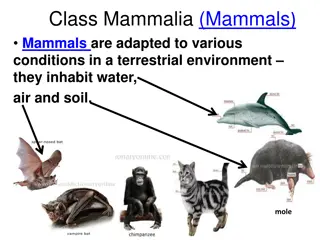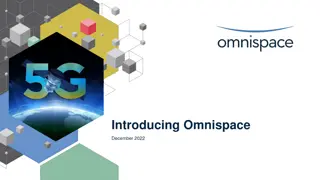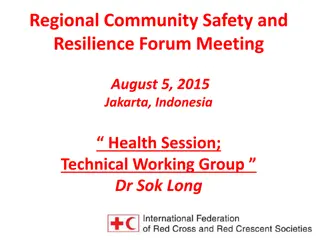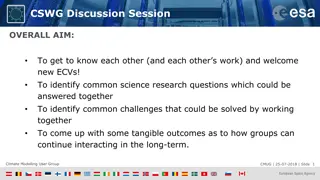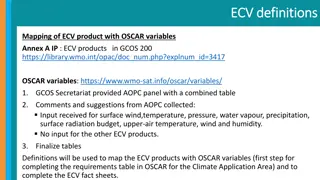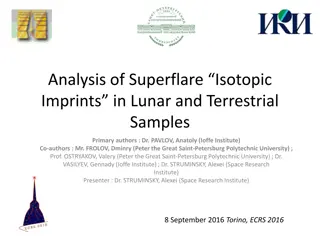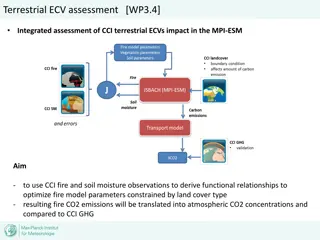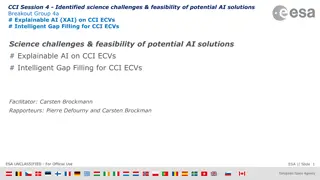Understanding Ecosystems: Types, Components, and Interactions
Different types of ecosystems, their components, and how they interact with each other. Explore natural ecosystems, such as deserts and rainforests, as well as artificial ecosystems. Discover the importance of terrestrial, aquatic, forest, marine, freshwater, tundra, and grassland ecosystems.
3 views • 6 slides
Advancements in Solar-Terrestrial Research and Meteorology
The Solar-Terrestrial Centre of Excellence (STCE) focuses on ongoing activities and opportunities in the field of meteorology, with a special emphasis on Antarctica. Their annual meetings cover topics like water vapor feedback mechanisms, extreme weather events forecasting, cloud and precipitation s
0 views • 14 slides
Digitalisation Trends in Govtech 2023: Insights and Challenges
Dive into the evolving landscape of digitalisation trends within government technology for 2023. Explore the impact of technological advancements, key metrics to assess readiness, and the paradigm shift towards abundance in digital transformation. Discover how BMIT contributes to informed ICT decisi
3 views • 21 slides
Understanding Terrestrial Planets and Core Dynamics
Exploring the core-mantle interaction from the early Hadean period to present times reveals intriguing questions about the outer core's electrical conductivity, geodynamo sustainability, and inner core characteristics. Studies indicate challenges in maintaining the geodynamo, potential heat sources
9 views • 48 slides
Influence of Solar Activity and Orbital Motion on Terrestrial Atmosphere
Solar magnetic field reversal, wavelet spectral analysis, and proxies for solar activity index are discussed in relation to the joint effects of solar activity and solar orbital motion on the Earth's atmosphere. The study highlights the impact of solar cycles on terrestrial climate dynamics and temp
6 views • 16 slides
TELECOMMUNICATIONS MEDIA
Telecommunications is the electronic transmission of information over distances, including voice calls, data, text, images, and video. It encompasses a range of technologies like fiber optics, satellites, telephones, and the Internet. Components of a telecommunications network include terminals, int
5 views • 13 slides
Understanding the Carbon Cycle: Reservoirs, Dynamics, and Importance
Earth's carbon cycle plays a crucial role in sustaining life, with carbon moving through various reservoirs and processes. This cycle involves short-term terrestrial and marine cycles, as well as long-term cycles influenced by volcanic activity and rock weathering. Understanding carbon reservoir dyn
6 views • 45 slides
Understanding Ecosystems: Ecological Interactions and Dependencies
Ecology is the study of how organisms interact with their environment, influencing their distribution and abundance. This exploration covers terrestrial and aquatic biomes, energy flow, environmental impacts, adaptations, and global ecosystems, emphasizing the interconnectedness of all living organi
2 views • 58 slides
Fascinating World of Mollusks: Traits and Habitats
Delve into the diverse world of mollusks, including snails, slugs, oysters, clams, octopuses, and squids. Learn about their soft-bodied nature, distinctive body plan, and varied habitats from marine to terrestrial. Discover how humans utilize mollusks for food and materials while also facing challen
4 views • 39 slides
Adaptations of Aquatic Specimens, with a Focus on Sea Snakes
Aquatic specimens, particularly sea snakes of the subfamily Hydrophiinae, exhibit fascinating adaptations for their fully aquatic lifestyle. These marine snakes are uniquely adapted for life in the sea, with specialized features such as paddle-like tails, compressed bodies, and the ability to respir
0 views • 16 slides
Factors Affecting Global Distribution of Plants and Animals
The distribution of plants and animals worldwide is influenced by abiotic and biotic factors. Factors such as rocks, food availability, air quality, water supply, and soil type play crucial roles in determining where species thrive. From the availability of nutrients like nitrogen and phosphorus to
0 views • 8 slides
Continental Drift, Theory of Tolerance & Major Biomes of the World Overview
This detailed presentation explores topics like Continental Drift, the Theory of Tolerance, and Major Biomes of the World. It covers the history of the Continental Drift theory, from Wegener to Du Toit's modifications, and delves into the various terrestrial biomes that exist, including tundra, bore
2 views • 26 slides
Environmental Challenges Facing the Great Barrier Reef
The management of the Great Barrier Reef has faced significant challenges leading to a decline in coral cover, dugong populations, seagrass health, and shark populations. Issues such as fishing practices, terrestrial pollutant runoff, and climate change have contributed to the deterioration of the r
0 views • 16 slides
Archegoniates: Primitive Plants with Unique Reproductive Structures
Archegoniates are a group of primitive plants believed to have originated from ancestral green algae. They possess distinct reproductive structures such as archegonia, which house the egg cell and give rise to the sporophytic generation. Heterospory in archegoniates leads to the formation of microsp
0 views • 15 slides
Respiration in Mollusca: Adaptations to Different Habitats
Mollusca exhibit various modes of respiration depending on their habitat - aquatic, terrestrial, or amphibious. Different respiratory organs are modified accordingly, such as ctenidia or gills for aquatic species, pulmonary sac for aerial species, and mantle or integument for those lacking specific
0 views • 17 slides
Ka-Band as Exemplary Band for NTN-NR in Satellite Services
Discussing the Ka-Band as a key frequency band for Non-Terrestrial Network-New Radio (NTN-NR) in satellite services, addressing its importance in enabling broadband access and bridging the digital divide. Proposals for endorsing Ka-Band, technical aspects, and studies conducted within 3GPP are highl
0 views • 9 slides
Proposal for Enhancing Security in RRC Connection Setup Procedure
Study the security mechanisms to secure the RRC connection setup process for the exchange of sensitive information between authentic network elements (BS and AMF) even before UE authentication. Addressing the lack of security in RRC Msg5 is crucial for various functionalities like Network Slicing an
1 views • 4 slides
Understanding Environmental Factors in Terrestrial and Aquatic Environments
Environmental factors play a crucial role in shaping ecosystems. In both terrestrial (land) and aquatic (water) environments, organisms are influenced by abiotic factors such as temperature, light intensity, and pH, as well as biotic factors like plants, predators, and competitors. Understanding the
4 views • 19 slides
The Diverse World of Molluscs: An Overview
Molluscs are diverse animals found in both terrestrial and aquatic habitats. They belong to Phylum Mollusca and exhibit characteristics such as a calciferous shell, bilateral symmetry, and a well-developed body system. The study of Molluscs is called Malacology, while the study of Molluscan Shells i
3 views • 11 slides
Detailed Overview of Peripatus Structure and Anatomy
Peripatus, a small terrestrial nocturnal creature resembling a caterpillar, lives under stones and logs near water. Its body is cylindrical with indistinct segmentation and superficial ring-like annuli. The head features antennae, mandibles, and oral papillae, while the trunk bears walking legs with
2 views • 27 slides
Understanding Radiation Pollution and Its Effects
Radiation pollution, whether ionizing or non-ionizing, is a significant environmental concern. Ionizing radiation can penetrate tissues and cause damage to living cells, while non-ionizing radiation may effectively sterilize microbes. Sources of radiation include cosmic rays, terrestrial elements li
0 views • 15 slides
Amphibian Metamorphosis: A Dive into Developmental Changes
Amphibian metamorphosis marks the transition from larval aquatic life to adult terrestrial existence. The process involves morphological transformations including tail resorption, gill destruction, and skin structure changes. Key changes in urodeles (salamanders) and anurans (frogs/toads) are outlin
1 views • 6 slides
Anatomy and Characteristics of Peripatus
Peripatus is a small, caterpillar-like terrestrial creature found in forests near water. It has dark grey or brown color, feeds on insects using mucous secreted by adhesive glands, and has a soft cylindrical body with bilateral symmetry. The body is divided into a head and trunk, with distinct featu
1 views • 27 slides
Challenges and Opportunities of Georgia's Digital Terrestrial Switchover
The transition to digital terrestrial broadcasting in Georgia posed challenges such as lack of strategy and clear vision in 2012, but also highlighted opportunities like civil society involvement and donor support. Contrasting government and civil society models for digital infrastructure ownership
0 views • 9 slides
Understanding Essential Climate Variables (ECV) and Their Requirements
Essential Climate Variables (ECVs) are physical, chemical, or biological variables crucial for characterizing Earth's climate. They provide empirical evidence for climate understanding, prediction, risk assessment, and more. ECVs must be relevant, feasible, and cost-effective, not as stand-alone var
0 views • 14 slides
Coupled Terrestrial-Coastal Modeling of Carbon Exchange in the Gulf of Mexico
Explore the interactions between terrestrial and coastal systems in the Mississippi-Atchafalaya Basin and Northern Gulf of Mexico through coupled terrestrial-coastal ocean modeling. The study focuses on carbon dynamics, uncertainties in coastal carbon budgets, and the NASA IDS project's approach. Fu
3 views • 26 slides
Adaptations and Characteristics of Mammals in Terrestrial Environments
Mammals are well adapted to various terrestrial conditions, inhabiting water, air, and soil. They maintain a stable body temperature, have fur for temperature regulation and protection, and unique limbs for different modes of movement. The distinguishing features of mammals include fur, specialized
0 views • 39 slides
Omnispace: Redefining Global Mobile Connectivity with 5G NTN Technology
Omnispace, launching in December 2022, introduces the world's first global hybrid mobile network using 5G NTN technology to revolutionize mobile connectivity for consumer, enterprise, government, and IoT users. The innovative 5G hybrid architecture combines global NGSO coverage and mobile network ro
0 views • 10 slides
Regional Community Safety and Resilience Forum Meeting Agenda August 5, 2015 Jakarta
The Regional Community Safety and Resilience Forum held a meeting in Jakarta on August 5, 2015, focusing on health-related topics. The agenda covered key issues in health, pandemic preparedness for MERS and Ebola, ECV roll out, CBHFA workshop, and future strategies for resilience. The forum highligh
0 views • 11 slides
Defining ECV Requirements and Implementation Guidelines
Understanding Essential Climate Variables (ECV) and their requirements is crucial for effective climate monitoring. This document outlines the steps and actions required to define ECV, participate in reviews, provide feedback, identify stewards, and more. Key tasks include reviewing WCRP Strategic P
0 views • 4 slides
Climate Modelling User Group Discussion Session Overview
The Climate Modelling User Group (CMUG) discussion session aims to foster collaboration among members, welcome new participants, identify common research questions and challenges, and establish long-term interaction mechanisms. The session includes presentations on ECV consistency and planetary visi
0 views • 15 slides
Mapping of ECV Products with OSCAR Variables for Climate Applications
This document outlines the mapping of Essential Climate Variables (ECV) products with OSCAR variables, focusing on surface wind, temperature, pressure, water vapor, precipitation, and more. It includes requirements, resolutions, frequencies, and measurement uncertainties for various atmospheric ECV
0 views • 10 slides
Integrated Terrestrial-Coastal Ocean Framework for Carbon Management
An advanced framework integrating terrestrial and coastal ocean observations and modeling is developed to support carbon management decisions. The study focuses on assessing the impacts of land use, human activities, and climate scenarios on the carbon cycle, particularly dissolved inorganic carbon
0 views • 5 slides
Analysis of Superflare Isotopic Imprints in Lunar and Terrestrial Samples
Researchers investigate isotopic imprints in lunar and terrestrial samples to understand extreme solar events and their impact on atmospheric radiocarbon concentrations. Using 10Be and 36Cl data, they analyze the solar proton spectra and energy fluxes associated with these events, shedding light on
0 views • 13 slides
Integrated Assessment of Terrestrial ECV Impact in MPI-ESM
Utilizing CCI fire and soil moisture observations to optimize fire model parameters in MPI-ESM. The study focuses on deriving functional relationships to enhance accuracy in predicting fire CO2 emissions and their impact on atmospheric CO2 concentrations compared to CCI GHG data. JSBACH-SPITFIRE fir
0 views • 7 slides
Workshop on Space Observation Capabilities for Climate Monitoring
This detailed content covers the Gap Analysis, Context, and Sustainability of Earth System Variables related to carbon, focusing on the Workshop on Sustained Space Observation Capabilities held in Darmstadt, Germany. It delves into the importance of the ECV Inventory, Gap Analysis, and recommendatio
0 views • 36 slides
Assessing Forest Loss in Protected Areas: A Philippines Case Study
The study assesses forest cover loss in terrestrial protected areas of the Philippines, analyzing the extent and rate of deforestation using Hansen's Global Forest Cover Change datasets. The research aims to understand the drivers of deforestation in protected areas, comparing forest loss in the ent
0 views • 24 slides
Terrestrial ECVs: Fire, Land Cover, Soil Moisture Overview
Detailed examination of Terrestrial Essential Climate Variables (ECVs) focusing on fire monitoring, land cover analysis, and soil moisture assessment. The information encompasses product summaries, error characterization methods, outreach efforts, user statistics, planned activities for phase 2, and
0 views • 8 slides
Challenges and Feasibility of Explainable AI and Gap Filling for CCI ECVs
Explainable AI (XAI) addresses the need for human-understandable AI models, contrasting with black box approaches. Intelligent gap filling for CCI ECV data is crucial but lacks efficient methods. Machine Learning can enhance EO data analysis with XAI insights, necessitating collaboration between dom
0 views • 8 slides
Future of ITU-D Study Question 8/1 Report Analysis
This report delves into the impact of terrestrial television broadcasting coexisting with telecommunication services, focusing on the transition to digital terrestrial television. It covers strategies for analogue switch-off, spectrum planning, and digital dividend use. The report also includes case
0 views • 16 slides


